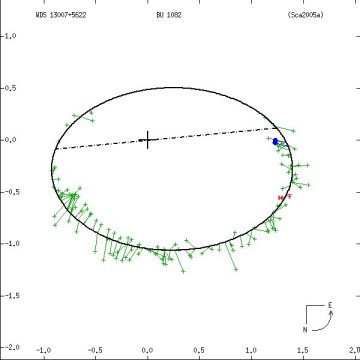
 |
78 Ursae Majoris B goes around 78 UMa A (the brighter and more massive of the two, placed at the cross) with a period of 106 years at an average separation of 31 1/4 Astronomical Units. Observations (the colored points) are missing where the stars were too close together. Tilted through a 50 degree angle to the plane of the sky, the orbit is quite noticeably foreshortened, as can be seen by the off-center displacement of the true ellipse's major axis (the dot-dash line). The arrow at lower right shows the direction of motion. Double star observers measure the position of the fainter star relative to the brighter rather than the actual motions of both stars around the common center of mass that lies between them. North is down, as would be seen in a telescope. The scales around the edges are in seconds of arc. (From an article by M. Scardia et al. in the Monthly Notices of the Royal Astronomical Socity, vol, 357, p. 1255, 2005, image courtesy of W. I. Hartkopf.) |